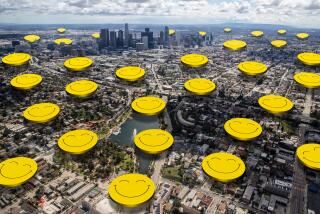L.A.’s quirky Smoking Deaths billboard
The Smoking Deaths billboard isn’t famous. It’s not the Hollywood sign or Rodeo Drive. Tourists don’t come to town clamoring to see Disneyland, Grauman’s Chinese Theatre and a billboard that counts up annual smoking deaths. But if you live in West L.A. anywhere near the 405, you know the sign. You’ve seen it looming over Santa Monica Boulevard, quietly toting up the number of Americans who’ve kicked the bucket after years of sucking on cancer sticks.
The Smoking Deaths billboard is black, with big white letters that say “Smoking Deaths This Year.” Underneath is a digital readout with a number that increases by one every minute or so. I usually pass it on my way to the gym or the self-serve frozen yogurt place. If there are 250,000 smoking deaths when I drive by, there might be 250,050 when I drive back.
The number you see up there is approximate, of course. Nobody’s calling hospitals to check the cancer wards. Still, it’s something to know that about 50 Americans died from lung cancer or heart disease or emphysema or chronic airway obstruction while I was struggling to bench-press all of 60 pounds, or choosing between Butterscotch, Forest Berry and Original Tart.
A guy named William E. Bloomfield put up the billboard in 1987. A former smoker himself, he got rich putting coin-operated washers and dryers in apartment buildings and college dorms. He said he wanted people to see the real cost of smoking. He didn’t anticipate the other, more upbeat public service the billboard would perform. I bet no one did.
My friend Eric J. Lawrence first told me about New Year’s Eveat the Smoking Deaths sign. Every year, just before midnight on Dec. 31, Eric walks the few blocks from his apartment to the billboard where a small crowd gathers, waiting. At 12, right on the dot, the digit on the far left of the counter changes to zero. And then the next one turns to zero, and the next, until all six digits are zeros. Then the zeros start disappearing one at a time, until all that’s left is one zero. Zero smoking deaths and counting. Everyone cheers. For a minute there on the sidewalk, Eric told me, it’s like Times Square.
I’ve never been a big fan ofNew Year’s Eve. The forced merriment makes my teeth hurt. I don’t see the charm of the end of a calendar year, when everyone grudgingly vows to lose weight and be a better person only to wind up older, fatter and meaner 12 months later. I’ve never been tempted to join the millions who huddle together shivering, in one city center or another, on the dubious principle that if enough people do something unpleasant at the same time, that makes it worthwhile. But New Year’s Eve at the Smoking Deaths billboard sounded like something I could get behind.
There was no one around when I got to the sign this New Year’s. Just drivers speeding down Santa Monica. Around 11:45, an SUV drove up. A group of twentysomethings got out. They were excited and a little drunk. They said they’d always wanted to see the sign turn over and this year they’d finally gotten themselves organized to come. Soon more people arrived: an older couple whose family tradition was to bring their daughter to watch the sign change; a woman with a nose ring who wondered if the whole event was an urban legend. Eric was there too; he’d made it with just minutes to spare.
There was someone else I hadn’t expected to see: Abundio Mireles, a middle-aged guy with a mustache who works for the sign company. It turns out the sign doesn’t reset itself automatically. Every year, Abundio climbs up to the roof of the small commercial building that supports the billboard, accesses the computer at the base of the sign and sets the counter back to zero. He uses his cellphone to time it. He says as long as he’s been doing it, almost 20 years now, there have always been people standing there in the street, waiting.
By midnight, about 30 celebrants had assembled, drawn by curiosity, tradition or the mild perversity of using this particular timer to usher in the New Year. They watched as the huge counter on the billboard slowly turned from 420,127 to six brightly lit zeros, and then to one zero. Some people cheered. The mood was light. Even the sign seemed to join the party: For this brief moment, there was not one smoking death in America.
And then, inevitably, the counter turned over. One death. Then two. Then three. After that, people walked home or drove away. Other cars kept stopping, though. More drivers got out and took photos. By the time I left, the death toll was up to 18.
Los Angeles is sometimes caricatured as a city with no center, a vast hive of individuals driving around isolated and rudderless. Yet on certain significant occasions, some of those individuals find ways to forge rituals and communities. They improvise if they have to. Because even malcontents who shun champagne and party hats on New Year’s Eve still seek out a memorable experience to be shared with strangers.
That’s how I see the Smoking Deaths billboard. It’s modest, and a bit on the morbid side, but as the centerpiece of an end-of-year ritual, it really works. Something about the way that counter turns over at midnight feels strangely like a rebirth. It’s a fresh start, a brief reprieve from grim reality. As much as a billboard counting smoking deaths can be, it’s like spring.
Gideon Brower, a playwright and screenwriter, is at work on a radio documentary about his longtime Santa Monica neighbor James “Whitey” Bulger.
More to Read
A cure for the common opinion
Get thought-provoking perspectives with our weekly newsletter.
You may occasionally receive promotional content from the Los Angeles Times.










